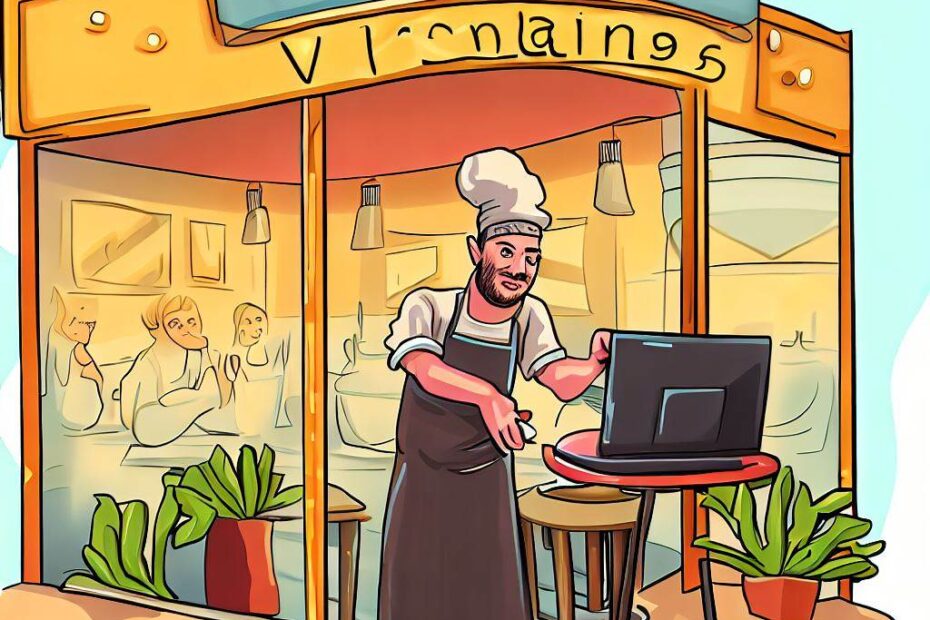How to Start a Virtual Restaurant? Starting a virtual restaurant can be an exciting and lucrative venture in today’s digital age. With the increasing popularity of food delivery apps and the growing demand for convenient dining options, a virtual restaurant allows you to capitalize on these trends without the need for a physical dining space. Here are some ideas to help you get started.
Understanding the Virtual Restaurant Concept
Virtual restaurants, also known as ghost kitchens or cloud kitchens, have gained significant popularity in recent years. These unique food establishments have surged in popularity over the last few years due to their operational strategy, which solely relies on online platforms and doesn’t involve a physical dining area. The elimination of the requirement for a traditional brick-and-mortar location sets virtual restaurants apart from their traditional counterparts, providing an affordable and flexible avenue for aspiring individuals to venture into the food industry. Consequently, for those interested in diving into this lucrative business concept, understanding the essential steps to initiate your very own virtual restaurant becomes crucial.
To begin, it is imperative to fathom the underlying principles that define virtual restaurants and their operational dynamics. A deeper knowledge of these aspects can help aspiring entrepreneurs to successfully navigate through this unique business arena. By conducting meticulous market research and thorough analysis of customer preferences, one can identify the ideal niche and target audience to cater to within the virtual restaurant industry.
Once a suitable target audience is determined, the next step entails formulating a compelling and comprehensive business plan. This plan should encompass crucial aspects such as a solid financial strategy, effective marketing techniques, and well-defined operational procedures. Developing strong partnerships with food delivery platforms can also play a pivotal role in ensuring the efficient delivery of food to customers.
Moreover, it is essential to invest in state-of-the-art technology and equipment to streamline the virtual restaurant’s operations. Implementing robust order management systems, advanced cooking techniques, and efficient delivery management software can enable owners to efficiently process incoming orders, prepare food, and swiftly deliver it to customers.
Furthermore, crafting a diverse and enticing menu that caters to the preferences and dietary requirements of the identified target audience can greatly contribute to the success of a virtual restaurant. Collaborating with skilled and passionate chefs can assist in designing innovative and delectable dishes that resonate with customers, fostering customer loyalty and satisfaction.
Beyond the initial launch, continuous monitoring and analysis of customer feedback, online reviews, and industry trends become integral to sustaining and growing the virtual restaurant. Adapting and evolving the menu, improving delivery processes, and effectively marketing the establishment using social media and online advertising can help virtual restaurants stay relevant and competitive in an ever-evolving market.
Thus, comprehending the intricacies of virtual restaurants, from their conceptualization to sustained growth, can empower ambitious individuals to embark on their own virtual restaurant journey successfully. By diligently executing the necessary steps, aspiring entrepreneurs can leverage the advantages of this innovative business model to establish themselves within the food industry.

Market Research and Concept Development
In order to successfully venture into the virtual restaurant industry, it is imperative to prioritize the undertaking of comprehensive market research and concept development. This vital step involves identifying the specific target audience which you intend to cater to, meticulously analyzing their needs and desires, and critically evaluating any potential competition already established within your desired location. Additionally, it is essential to gather extensive data regarding consumer preferences, local market trends, and efficient delivery logistics.
Conducting thorough market research is an indispensable component when aiming to create a virtual restaurant concept that is both distinctive and enticing to consumers. By examining and understanding your target audience, it becomes possible to identify their preferences, habits, and expectations. This knowledge will allow for the development of a concept that precisely fulfills the unique requirements of your potential customers.
Furthermore, assessing the existing competition within your desired location is of utmost importance. This evaluation enables you to gain insights into the strategies employed by competitors, their strengths and weaknesses, and the overall saturation of the market. Armed with this information, you can then refine and differentiate your concept to effectively stand out from the competition.
Obtaining data on consumer preferences, local market trends, and delivery logistics is paramount for a virtual restaurant’s success. By understanding what consumers desire and expect, you can tailor your concept to cater directly to their needs, ensuring a high level of customer satisfaction. Additionally, keeping abreast of local market trends will enable you to adapt and innovate accordingly, staying ahead of the curve. Lastly, establishing efficient delivery logistics is crucial for a virtual restaurant, as it directly impacts customer experience and contributes to the overall success and growth of the business.
Overall, conducting comprehensive market research and concept development is an indispensable foundation for anyone looking to venture into the virtual restaurant industry. It provides valuable insights into the target audience, competitors, consumer preferences, market trends, and delivery logistics, facilitating the creation of a unique and appealing concept that effectively meets the needs and desires of consumers.

Legal and Licensing Requirements
Complying with legal and licensing requirements is a crucial aspect that should not be overlooked to ensure smooth operations for a virtual restaurant. Acquiring essential permits, including a business license and food handling certificates, is of utmost importance. These permits serve as evidence that your establishment is authorized to operate and maintain high standards when it comes to food safety.
An effective strategy to guarantee adherence to regulations is to seek guidance from the local health department. Such consultation will help you fully comprehend the specific regulations relating to food preparation and delivery. This collaboration will offer invaluable insights that are instrumental in implementing best practices and keeping customers safe.
Obtaining a business license is imperative as it grants official authorization to conduct business operations in compliance with legal requirements. This license serves as proof that your virtual restaurant is legitimate and operates within the confines of the law.
Food handling certificates serve as a testament to the proficiency of your staff in maintaining adequate sanitation and food safety measures. Customers appreciate knowing that your team has received the necessary training, ensuring the safe handling and preparation of their meals.
By addressing all legal and licensing requirements, your virtual restaurant stands a better chance of gaining the trust of both regulatory authorities and customers. This not only enhances your reputation but also minimizes the risk of facing penalties or even closure due to non-compliance.
By prioritizing legal and licensing requirements is crucial for the success and sustainability of your virtual restaurant. Acquiring permits, licenses, and certifications showcases your commitment to both legal compliance and the well-being of your customers. Collaborating with local health departments will provide you with invaluable guidance, enabling you to implement the appropriate food preparation and delivery practices while ensuring the highest level of safety for all involved.

Building Your Online Presence
When it comes to the virtual restaurant business, establishing a robust online presence is of utmost importance. To achieve this, it is crucial to begin by crafting an aesthetically pleasing and intuitive website. By doing so, your online platform will instantly captivate visitors, leaving a lasting impression on potential customers.
To amplify your website’s visibility on popular search engines, such as Google, incorporate pertinent keywords throughout your website’s content. This will enable search engine algorithms to identify your website as a relevant source of information to users searching for specific criteria. Additionally, implementing meta tags and descriptive alt tags for images will further enhance your website’s visibility and accessibility to both search engines and visually impaired individuals.
An integral aspect of building your online presence entails showcasing the excellence of your culinary creations. Ensure that your website contains a repertoire of high-quality photographs, illustrating each delectable dish on your menu. By visually stimulating visitors, these images will entice their taste buds and create an irresistible desire to experience your gastronomic offerings firsthand.
Offering detailed and comprehensive menus is indispensable for enticing potential customers to frequent your virtual restaurant. By providing an extensive and concise description of each dish, visitors will feel informed and compelled to explore a multitude of palate-pleasing options. Furthermore, offering convenient and user-friendly ordering options, such as online reservation systems or delivery services, will add an extra layer of convenience for customers looking to savor your culinary delights.
By dedicating time and effort to establish a compelling online presence, your virtual restaurant will transform into a thriving digital destination. By creating an enticing website, optimizing it for search engines, showcasing alluring images of your dishes, and offering convenient ordering options, you will undoubtedly attract a multitude of eager customers ready to experience your culinary expertise.

Partnering with Food Delivery Platforms
Collaborating with food delivery platforms is essential to reach a wider audience and streamline your operations. Research and engage with popular platforms that operate in your desired location. By partnering with these platforms, businesses can significantly expand their reach and tap into a much larger audience.
Researching and engaging with popular food delivery platforms that operate in your desired location is the first step towards strengthening your business’s online presence. Conducting thorough research will enable you to identify the platforms that are most suitable for your business, ensuring that you align with those that have a large customer base and a strong reputation.
Collaboration with these services offers numerous benefits for your virtual restaurant. First and foremost, partnering with food delivery platforms grants you access to their existing customer base. This means that you can instantly connect with a wide range of potential customers who are already familiar with and frequent users of the platform. This access to a substantial customer base can greatly enhance your brand’s visibility and increase the likelihood of attracting new loyal customers.
In addition to expanding your customer reach, partnering with food delivery platforms can also streamline your operations. These platforms typically provide integrated solutions that simplify the ordering and delivery process. By utilizing their technology and resources, you can efficiently manage incoming orders, track deliveries, and handle payments, freeing up valuable time and resources that can be redirected towards improving your overall service and customer experience.
Collaborating with food delivery platforms is not only essential but also highly advantageous for virtual restaurants aiming to maximize their growth potential. With a wider audience reach and streamlined operations, businesses can position themselves for success in the competitive industry and ensure long-term sustainability.

Menu Development and Pricing Strategy
Creating a diverse and appealing virtual menu is an essential aspect of achieving success in the restaurant industry. It is crucial to take into account several factors such as your target audience, local preferences, and the availability of ingredients in order to craft an enticing and well-curated menu that meets the expectations of your customers. By offering a wide range of options, you can ensure that your virtual restaurant caters to various dietary needs and preferences, attracting a larger customer base.
In addition to menu development, it is equally important to develop an effective pricing strategy that aligns with your production costs, competition, and target market. Conduct thorough research and analysis of the pricing models employed by similar virtual restaurants in order to gain a clearer understanding of the market landscape. This will help you strike a balance between affordability and profitability, ensuring that your prices are competitive and attractive to customers while still allowing you to achieve a healthy profit margin.
When considering pricing, it is important to evaluate and identify your production costs accurately. This includes ingredient costs, labor expenses, packaging, and delivery costs if applicable. Understanding your costs will allow you to set realistic prices that account for these expenses. Furthermore, consider the competition in the virtual restaurant industry and price your menu items accordingly. Conducting a competitor analysis will give you insights into the pricing strategies adopted by others, helping you position your menu at a competitive level.
Moreover, always keep your target market in mind when developing your pricing strategy. Consider factors such as the average income of your target customers and their willingness to pay for your offerings. By aligning your prices with the preferences and financial capabilities of your target market, you can ensure that your pricing strategy is effective in attracting and retaining customers while preserving your profitability.
A successful menu development and pricing strategy involves a thoughtful consideration of various factors such as local preferences, dietary needs, production costs, competition, and target market. By thoroughly analyzing these factors and implementing a well-balanced approach that takes into account affordability and profitability, you can position your virtual restaurant for long-term success and customer satisfaction.

Effective Marketing and Promotion
To ensure the successful launch of your virtual restaurant, it is crucial to allocate sufficient resources for marketing and promotion. Leveraging the potential of social media platforms is an effective strategy to engage with potential customers and reach a wider audience. Utilize these platforms to not only communicate and interact with your target market but also to showcase enticing images of your delectable dishes. Captivating visuals can instantly grab attention and entice potential customers to explore your menu further.
In addition to utilizing social media, collaborating with influencers or bloggers in the food industry can significantly enhance your online visibility. These influencers have a substantial following and their recommendations can greatly impact the perception of your virtual restaurant, generating interest and attracting potential customers.
However, a successful marketing and promotion strategy goes beyond just social media and influencer collaborations. It is essential to create exclusive promotions that entice customers to try your virtual restaurant. These promotions could include limited-time offers, discounts, or loyalty programs. By offering incentives, customers are more likely to choose your restaurant over competitors.
Furthermore, maintaining a strong online presence is key. Ensure that your branding is consistent across all platforms and your website is optimized for search engines. Engage with customers by responding to their reviews and feedback promptly. By offering excellent customer service and a personalized experience, you can build a loyal customer base and generate positive word-of-mouth.
Effective marketing and promotion are vital for the success of your virtual restaurant. Utilize social media platforms, collaborate with industry influencers, offer exclusive promotions, maintain a strong online presence, and focus on providing excellent customer service. These strategies will help attract potential customers, increase your online visibility, and create a favorable brand image, ultimately leading to the long-term success of your virtual restaurant.

Managing Operations and Customer Service
The efficient management of operations and the provision of exceptional customer service are pivotal elements that underpin the success of a virtual restaurant. To achieve this, it is crucial to implement robust order processing systems that can handle a high volume of orders seamlessly. By optimizing delivery logistics, you can ensure that the food reaches customers in a timely manner, maintaining the quality and freshness of the dishes. Additionally, it is essential to prioritize the security of payments to build trust and loyalty among your customers.
Furthermore, to maintain consistency and provide an excellent customer experience, it is vital to streamline all aspects of your operations. This can be achieved by establishing standardized procedures and protocols across the various departments of your virtual restaurant. By doing so, you can minimize errors, eliminate bottlenecks, and improve overall efficiency.
Moreover, it is essential to embrace technology and leverage it to enhance your operations and customer service. Implementing state-of-the-art software and technological tools can automate repetitive tasks, reduce manual errors, and provide real-time insights into the performance of your virtual restaurant. Such advancements can also enable you to offer personalized experiences for your customers, enhancing their satisfaction and building long-lasting relationships.
In addition, effective communication and collaboration within your team is crucial. Encourage open lines of communication and provide regular training to ensure that every team member is equipped with the necessary skills and knowledge to excel in their roles. By fostering a positive work environment and empowering your staff, you can create a motivated and cohesive team that is committed to delivering exceptional customer service.
Ultimately, by prioritizing efficient operations and exceptional customer service, your virtual restaurant can thrive in a competitive market and build a strong brand reputation.

Evaluating Performance and Adapting
To ensure the success and profitability of your virtual restaurant, it is imperative to regularly evaluate its performance and make necessary adaptations. This can be accomplished through a systematic analysis of key performance indicators (KPIs), which will provide valuable insights into the overall effectiveness of your business.
One crucial aspect to monitor is the order volume. By closely examining the number of orders placed, you can identify patterns and trends that can inform your decision-making process. Additionally, keeping a keen eye on customer feedback enables you to gauge customer satisfaction levels and make thoughtful adjustments accordingly.
Another vital metric to track is the average delivery time. This metric is directly linked to customer experience and can greatly impact their level of satisfaction. By constantly monitoring the delivery time, you can identify any bottlenecks or areas of improvement within your delivery process.
In order to stay ahead of the competition and meet evolving customer demands, it is essential to adapt your strategies, menu, and marketing efforts. Analyzing customer preferences and market trends will allow you to identify opportunities to enhance your virtual restaurant’s performance. For example, if customer feedback indicates a growing interest in plant-based options, you can consider adding more vegetarian or vegan dishes to your menu.
Furthermore, regularly analyzing market trends will help you understand consumer behavior, enabling you to tailor your marketing efforts effectively. For instance, if social media platforms are gaining popularity among your target audience, investing more in social media marketing campaigns can yield positive results.
By continuously evaluating key performance indicators and adapting your strategies to customer preferences and market trends, you can ensure the continuous improvement of your virtual restaurant’s performance. This proactive approach will ultimately lead to higher levels of success and profitability, establishing your virtual restaurant as a strong player in the highly competitive food industry.

Conclusion
This comprehensive guide provides practical insights into starting a virtual restaurant and covers important aspects such as market research, legal requirements, online presence, menu development, marketing, customer service, and performance evaluation. By following these steps and utilizing the resources provided, you can set yourself up for success in the virtual restaurant industry. Good luck on your journey to becoming a thriving virtual restaurant owner!
